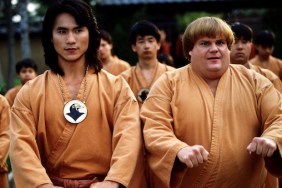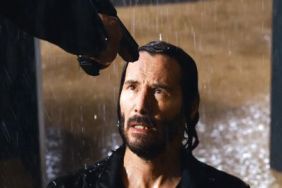He takes to the center of the ring. The people cheer. He wears a bright silver mask, which exposes only his eyes, nose, and lips. He wears a cape and tight pants. His physique is swollen and glorious. He is tall and clearly powerful. The audience chants his name. He absorbs their adulation, but remains quiet and humble. He is more than a man. He is a saint. He removes his shimmering cloak, and retires to his corner. Into the ring now comes a slightly smaller man, also wearing a similar mask. He wears black pants and seems to have hair sticking out from underneath it. The crowd begins to hiss violently. They jeer and curse this new interloper. He goads them on, challenging them, mocking them. This rude man will fight the saint. A bell will ring, and the two competitors will grapple with one another, tossing each other about bodily, and tackling each other without pity or forgiveness. The silver-faced saint occasionally looks to falter, but will gain the upper hand in the end. The saint will keep his opponent pinned to the mat, twisting his legs and punching his kidneys. The saint can be violent. He will eventually punish the interloper for his churlish challenge. The saint will be the winner. He sends love out to his fans. They cry and cheer and prostrate themselves to his awesome physical glory.
This is the glory that is Lucha Libre, one of the finest sports in the history of human civilization.
Okay, okay. Enough of all this cinematic theory and dull, deadpan looks at dead film directors. It is time to delve into a stranger corner of film history. A really, really strange corner. And one that will offer bizarre pleasures to even the most jaded of exploitation movie fanatics, and will expose the outsize personalities of some of the most charismatic athletes to ever stride into a wrestling ring. In this week’s lesson in CraveOnline’s Free Film School, hosted by me, Professor Witney Seibold, we will be taking a good hard look at one of Mexico’s most relevant contributions to the world of B-movies. We will be talking about Lucha Film.

Lucha Libre (literally “free wrestling”) was founded in earnest in the early 1930s, when the freestyle amateur wrestling popular throughout Mexico was organized into an official sporting event. Free from the constraints of the stuffy, rule-oriented Greco-Roman wrestling, Lucha Libre was a sloppier, flashier version of the wrestling usually exhibited in the Olympic Games. It persisted in high popularity until 1950. When televised Lucha Libre matches started to be broadcast all over the country, the sport became a national obsession, spawning its own rules, sub-cultures, and celebrity superstar wrestlers. Any sort of demonstrative showmanship you see in today’s American WWE pro-wrestling events is a direct descendant of Mexico’s Lucha traditions.
Oh the varieties of Lucha Libre are endless. There are luchadors who dress as cats. There are dwarf luchador divisions. There are female luchador divisions. Each Lucha match is usually a rudo (the bad guy) vs. a técnico (the good guy). The luchadors would invent entire personae for themselves, giving themselves mysterious histories and elaborate in-ring personalities. This is another tradition that has passed into American pro-wrestling.
Lucha Libre, indeed, became so popular, that Mexico’s comparatively small filmmaking industry was quick to pick up luchadors as film heroes. The first feature film to star a luchador was the obscure 1952 film Huracán Ramírez, a mild success in its day. Despite the obscurity and dubious artistic merit of the film, it launched a trend. A subgenre was born. Soon all manner of luchadors began appearing in films, and real-life kings of the ring began to make the transition to film. Some film scholars have numbered luchador films at about 150, but it’s more likely that there are hundreds more low-budget Mexican wrestling films that are lost to history.

I recall seeing luchador films on the Spanish-language TV stations as a child. These were films unlike any I had seen before. They resembled low-budget American monster films in many ways (they often had monsters or vampires in them), but had a strange kind of earnest energy to them that I couldn’t describe. There was an efficiency to the storytelling that American filmmakers rarely captured. These were films that existed solely to lionize an already-popular folk hero, playing himself, and extend his myth into a supernatural place where he would defeat all his opponents in the ring, best any supernatural monster that beset him, and still have time to wear nice suits, drive nice cars, and pick up beautiful Mexican women. They were shamelessly self-aggrandizing, always very cheap (none of the luchador films had big budgets), and often hopelessly convoluted. But they had something many exploitation movies of the America lacked: They had a myth.
Most of the luchadors you see in Lucha films were, you see, real-life wrestling champs outside of the film. Known only by their specialty wrestling names, and never, ever seen without their masks, luchadors became local folk heroes of a sort. They would fight for their honor, and for the honor of their fans. Despite the cartoony appeal they possess these days, luchadors were superhuman bastions of their communities. We know the names and histories of some of the more popular luchadors today, but mentioning the name of Rodolfo Guzmán Huerta will only elicit blank looks from most people. But watch their faces fly into expressions of ecstasy as you mention the hallowed named of El Santo, the single biggest superstar in all Lucha history.
El Santo, you will find, is one of the most recognizable faces in all pop culture history. Not only was he a folk hero and wrestling icon, but he starred in his own comic books, and he was a pertinent film star. In 1958, Santo was invited to appear in a feature film called El Cerebro del Mal (The Bad Brain), in which he wore his signature mask, but only acted as sidekick to another luchador named El Incognito. El Santo’s career wouldn’t take off in earnest until the early 1960s, and he would make some of the finest of Lucha films.

Lucha films are really effing weird. The wrestlers, playing themselves, would often be recast as well-dressed ladies’ men (but never lotharios) who would jet set around town, attending classy parties, and blessing the community with their presence. They never removed their masks. They were perfect, peerless heroes, capable of being wealthy, but still helping the little people. They would never fight for the wrong reason. They would wrestle with honor. Then, to get the story going, they would be given an antagonist whom they would eventually have to fight. The antagonist in luchador films, though, was very rarely just another wrestler. It was usually a famous monster of some kind. In his film career, El Santo fought Dracula, a mummy, a banshee, a werewolf, Frankenstein’s monster, and sexy vampire women. In one notable film, El Santo teamed up with the very popular Blue Demon to fight a monster mash of several beasties. The 1969 film Santo y Blue Demon contra Los Monstruos featured a sci-fi lab that simultaneously brainwashed a mummy, Frankenstein’s monster (sporting a bandito mustache), a wolf man, and some sort of lizard dwarf creature with an exposed brain. The film looks as if someone cracked open my ten-year-old brain, and let every unfettered pop culture fantasy free.
Luchador films enjoyed a cult audience in America thanks to a film producer named K. Gordon Murray (1922 -1979), a well-known exporter of fantasy B-movies and an exploitation luminary. Any semi-serious student of trash cinema ought to know the name of K. Gordon Murray. Murray would travel to other countries, find some of the little-known fairy tale films, and redub them into English for American audiences. He’s often cited as one of the kings of the early 1950s “Kiddie Matinees,” back in the day when children’s features were shown in local American cinemas before the more grown-up fare later in the evening. Films like Santa Claus (1959), The Robot vs. The Aztec Mummy (1957), and The Golden Goose (1969) are well known to a generation of trash-film lovers thanks to Murray. Some of his films, in turn, became featured on Mystery Science Theater 3000, and the generational trash torch was passed. Murray was the one who carried the luchador films to the U.S., sometimes (bafflingly) redubbing El Santo’s name as “Sampson.” The kids who grew up looking through the back corners of UHF stations would find luchador movies sandwiched in between lesser-known Japanese kaiju films. Nothing can be more striking that discovering these movies at just the right age.
I should point out that El Santo’s movies, as well as the vast bulk of Lucha movies, were hardly professional. They were badly lit, the sound was rarely properly audible, the stories would meander, and the dialogue (dubbed or not) would contain some of the weirdest mutilations of English (or Spanish) this side of an Ed Wood movie. By all conventional professional accounts, these were bad films. Like all B-movies, the Lucha films were often produced quickly and on the cheap. Studios would release several in the span of a year. Like slasher films today, studios saw Lucha films as a quick buck, as people would see them even if they weren’t expensively made. I wouldn’t have it any other way. A slick, big-budget version of an El Santo movie would only serve to erode its charm. There is a certain joy in the earnestness of a badly made film. El Santo was so, well, saintly, that his heroic purity would only be amplified by the film’s cheapness. There was something about El Santo – some “it” quality – that left him untainted, no matter how much canonical double-backing and confusion he had applied to him. He was like Superman, but with the benefit of being a real athlete.

The finest of all Lucha films is widely held to be the 1962 classic Santo contra Mujeres Vampiro, as it was one of the first Santo film to give him a sort of background as a crimefighter, and regular battler of evil monsters. Lucha films place their heroes somewhere between the real and the fanciful. They seem to be making part-documentaries about their subjects, despite the presence of vampire women and cheesy special effects. No other fantasy film has that quality. I’ve heard some argue that comic book superheroes of today are as important to us as Greek heroes like Odysseus were to the ancient Greeks. This is not entirely accurate. The luchadors are perhaps a bit more of an appropriate analogy. Odysseus was a half-real hero who was aided by gods. El Santo, one could argue, fits that mold perfectly.
El Santo made 52 Lucha films in his vast and varied career, spanning from 1958 to 1982. El Santo retired in 1982, in that he removed his mask on national television. This was the only time he was seen to remove his mask in public. He had a heart attack in 1984, and died at the age of 66. His legacy lives on in the cultural consciousness of the Mexican world, and in the form of other wrestlers with names like El Hijo del Santo (The Son of the Saint).
Cheesy, fun, trashy, cheap, sporty, and tapping into the unfettered myth of a local people, luchador films are unique in the annals of cinema. If you want a regular old superhero story, go ahead and watch The Dark Knight again. If you want a truly epic hero, watch El Santo at work. He is more important than Batman.
HOMEWORK FOR THE WEEK: They aren’t widely available on home video or on downloading services, but see if you can track down any Lucha films. If you live near the Mexican border, find a flyer for a real-life Lucha Libre match, and try to attend. Take part in Mexico’s grand tradition. Consider the place fantasy heroes play in your life. How “real” are they in your mind? How much cognitive space do they take up? How does your view of your movie hero match with the world’s perception of them?








